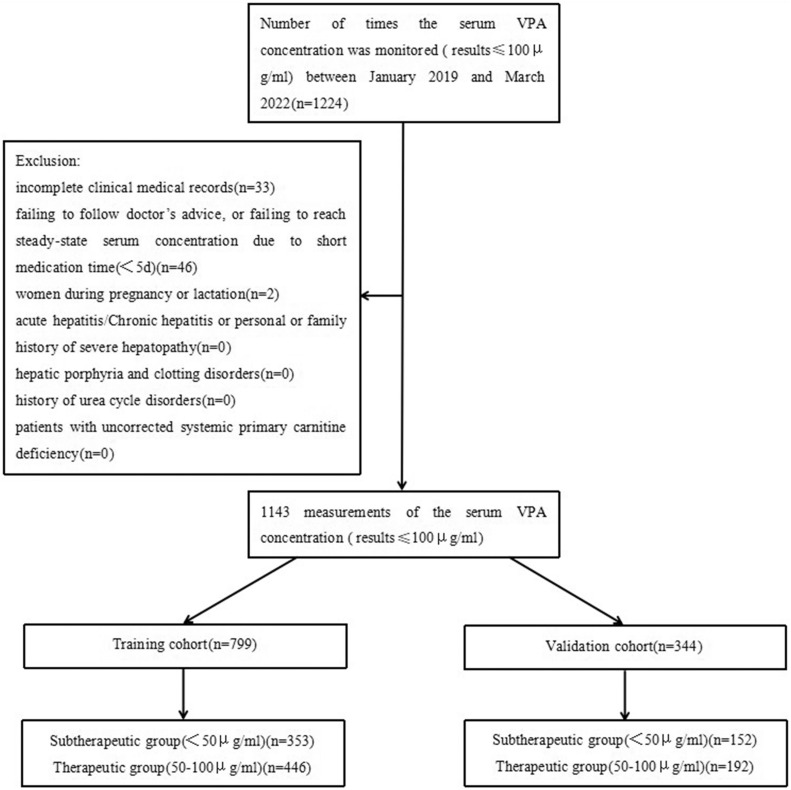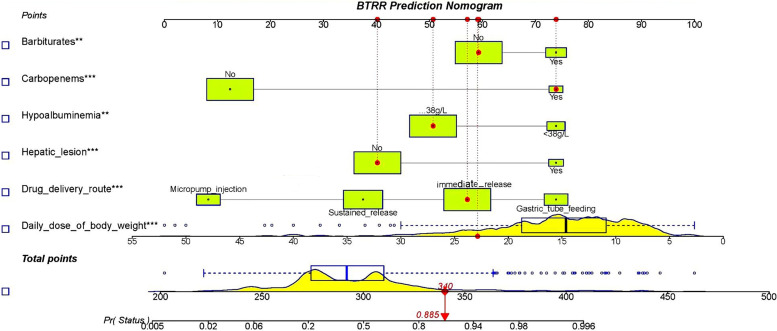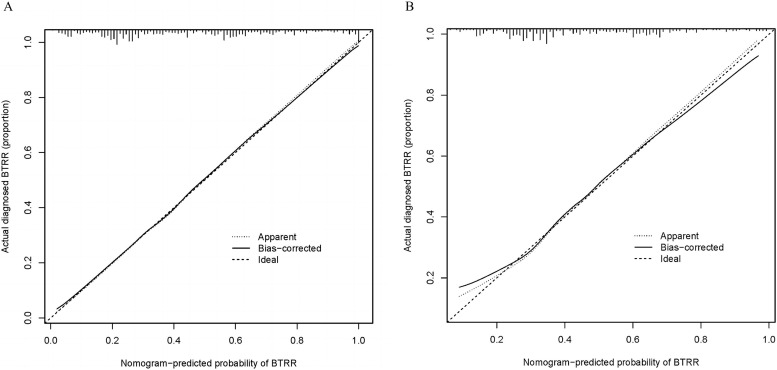预测中国癫痫患者血清丙戊酸浓度不达标的临床Nomogram。
IF 1.5
Q3 MEDICINE, RESEARCH & EXPERIMENTAL
Current Therapeutic Research-clinical and Experimental
Pub Date : 2025-01-01
DOI:10.1016/j.curtheres.2024.100771
引用次数: 0
摘要
背景:众所周知,血清丙戊酸(VPA)浓度不达标可能导致癫痫治疗失败。然而,目前仍缺乏一种快速预测患者血清VPA浓度是否达标的方法。目的:探讨导致中国癫痫患者血清VPA浓度不达标的因素,并建立相关的图图进行风险预测。方法:采集2019年1月至2022年3月六安市人民医院药剂科监测的630例中国住院癫痫患者血清VPA浓度1143份,收集完整的临床资料进行回顾性分析。所有监测的血清VPA浓度进一步分为训练组和验证组。对于训练组,血清VPA浓度低于50 µg/mL和在50 ~ 100 µg/mL之间分别被分为亚治疗组和治疗组。从临床资料中选取变量,分析亚治疗组和治疗组变量之间的差异。通过logistic回归分析筛选出导致血清VPA浓度不达标的影响因素,并利用筛选出的影响因素建立nomogram预测模型。结果:多因素logistic回归分析显示,单位体重日剂量(mg/kg/d)、给药途径、是否存在肝脏病变、低白蛋白血症、是否联用碳青霉烯类药物或巴比妥类药物是影响血清VPA浓度不达标的独立因素。在多元logistic回归分析结果的基础上,建立血清VPA浓度不达标的nomogram风险预测模型。c指数值和内部验证结果表明,模态图模型具有较好的准确性和鉴别性。决策曲线显示,预测血清VPA浓度不达标风险的nomogram具有较大的净效益值(范围为12% ~ 94%),说明该模型具有较宽的预测区间。结论:本研究建立了中国癫痫患者血清VPA浓度不达标的nomogram风险预测模型,可以帮助医生或患者尽快将血清VPA浓度控制在目标浓度范围内。本文章由计算机程序翻译,如有差异,请以英文原文为准。



A Clinical Nomogram for Predicting Substandard Serum Valproic Acid Concentrations in Chinese Patients With Epilepsy
Background
It is well-known that substandard serum valproic acid (VPA) concentrations may lead to treatment failure of epilepsy. However, there is still a lack of a quick method to predict whether a patient's serum VPA concentration will reach the standard.
Objective
The aims of this study were to investigate the factors leading to substandard serum VPA concentrations in Chinese patients with epilepsy and develop a related nomogram for risk prediction.
Methods
From January 2019 to March 2022, a total of 1143 serum VPA concentrations were collected from 630 hospitalized Chinese patients with epilepsy who were monitored by the Department of Pharmacy of Lu'an People's Hospital, and complete clinical data were collected from the corresponding patients for retrospective analysis. All monitored serum VPA concentrations were further divided into a training cohort and a validation cohort. For the training cohort, serum VPA concentrations below 50 µg/mL and between 50 and 100 µg/mL were classified into the subtherapeutic group and therapeutic group, respectively. The variables were selected from the clinical data, and differences between the variables of the subtherapeutic and therapeutic groups were analyzed. The influencing factors leading to substandard serum VPA concentrations were screened via logistic regression analysis, and the screened influencing factors were used to establish the nomogram prediction model.
Results
Multivariate logistic regression analysis revealed that the daily dose per unit of body weight (mg/kg/d), route of administration, presence of hepatic lesions, hypoalbuminemia, and combination with carbapenems or barbiturates were independent factors influencing the occurrence of substandard serum VPA concentrations. On the basis of the results of the multivariate logistic regression analysis, a nomogram risk prediction model for substandard serum VPA concentration was established. The values of the C-index and internal verification results indicated that the nomogram model had good accuracy and discrimination. The decision curve revealed that the nomogram that predicted the risk of substandard serum VPA concentration had a greater net benefit value (ranging from 12% to 94%), indicating that the model had a wide prediction interval.
Conclusions
Our study established a nomogram risk prediction model for substandard serum VPA concentrations in Chinese patients with epilepsy, which can help doctors or patients control the serum VPA concentration within the target concentration range as soon as possible.
求助全文
通过发布文献求助,成功后即可免费获取论文全文。
去求助
来源期刊
CiteScore
3.50
自引率
0.00%
发文量
31
审稿时长
3 months
期刊介绍:
We also encourage the submission of manuscripts presenting preclinical and very preliminary research that may stimulate further investigation of potentially relevant findings, as well as in-depth review articles on specific therapies or disease states, and applied health delivery or pharmacoeconomics.
CTR encourages and supports the submission of manuscripts describing:
• Interventions designed to understand or improve human health, disease treatment or disease prevention;
• Studies that focus on problems that are uncommon in resource-rich countries;
• Research that is "under-published" because of limited access to monetary resources such as English language support and Open Access fees (CTR offers deeply discounted English language editing);
• Republication of articles previously published in non-English journals (eg, evidence-based guidelines) which could be useful if translated into English;
• Preclinical and clinical product development studies that are not pursued for further investigation based upon early phase results.

 求助内容:
求助内容: 应助结果提醒方式:
应助结果提醒方式:


